When was the last time you gave it a good scrub? From muddy paw prints to the occasional accident, dog bed silently collects a host of unsavoury moments. Why Your Dog’s Bed Needs Regular Washing? and How to wash a dog bed?🛏️
Stay with us, and we’ll clear up the secrets to keeping your dog’s bed consistently fresh and inviting. So, grab those rubber gloves, and let’s begin our mission to a happier, healthier, and distinctly less stinking dog!🐶

How to Wash a Dog Bed?
Cleaning your dog’s bed is important as they spend a lot of time on their beds, and they can leave behind hair, dirt, saliva, and germs. These can accumulate over time and create an unhealthy environment for your pet.
“Wash your dog’s bed once a week or once every two weeks⌛ at minimum, said the experts at PetMD“
Knowing how to clean your dog’s bed is important because it is probably littered with dirt, urine, and poop stains, so let’s see what you will need to clean the bed:
| Supplies | Usage |
|---|---|
| Vacuum Cleaner with Attachment | Use to remove loose fur, dirt, and debris from the bed🛏️ before washing. |
| Laundry Basket or Bag | Transport the dog bed cover or liner to the washing machine cleanly. |
| Mild Detergent | Choose a gentle, pet-friendly detergent without harsh chemicals. |
| Stain Remover (if needed) | Use a pet-safe stain remover for stubborn stains, following instructions. |
| Rubber Gloves | Protect your hands🙌 from allergens and chemicals during the process. |
| Laundry Instructions | Refer to care labels for specific temperature🌡️ and washing guidelines. |
| Lint Roller | After washing and drying, use it to remove remaining pet hair or lint. |

1. Preparing the Dog Bed
Before washing, it’s essential to eliminate as much loose fur and debris as possible. Using a vacuum cleaner with an upholstery attachment, carefully vacuum the entire surface of the bed. Pay extra attention to seams, creases, and corners where dirt tends to hide.
Inspect the bed closely for any visible stains. If you discover stains, consider using a pet-safe stain remover. Follow the product’s instructions carefully, allowing it to sit for the recommended time to break down the stain.
When treating stains, avoid aggressive rubbing, as it can spread the stain. Instead, gently blot the area with a clean cloth or paper towel. Depending on the stain remover used, you may need to rinse the area with clean water to remove any residue.
If you find yourself needing to make a new dog bed, check out our guide on, "how to make a dog bed?".
2. Machine Washing
Machine washing your dog’s bed can be an efficient way to clean it, but it’s essential to do it correctly to avoid any mishaps.
- Size Matters: If your dog’s bed is large, consider taking it to a laundromat with industrial-sized machines. Smaller beds may fit in a standard home washing machine.
- Gentle Cycle: Always opt for the gentle cycle or a dedicated bedding cycle if your washing machine has one. Using a gentle setting helps protect the bed’s fabric and padding from excessive wear and tear.
- Temperature: Typically, a cold or lukewarm water setting is suitable for most dog beds, as hot water can damage the fabric or cause shrinking.
- Detergent: Stick to a mild, pet-friendly detergent without harsh chemicals or strong fragrances. Using too much detergent can leave residue on the bed.
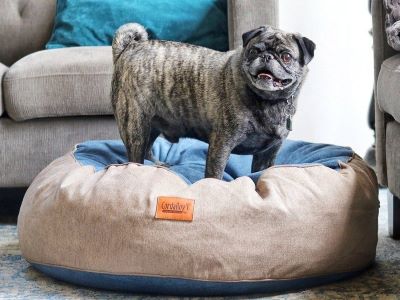
Here are some Dos and Don’ts of Washing Your Dog’s Bed in Machine:
| Dos | Don’ts |
|---|---|
| Check for loose parts | Overload the washing machine |
| Use a laundry bag | Use harsh detergents |
| Balance the washing machine load | Use bleach or fabric softeners |
| Air dry | Use high heat drying |
| Follow care label instructions | Ignore care label instructions📃 |
3. Hand Washing
When Machine Washing Isn’t an Option, hand washing can be a reliable alternative[1].
- Fill a Tub or Basin: Find a large tub or basin that can comfortably accommodate the bed. It should be big enough to allow for adequate movement during washing.
- Cleaning Solution: Use a mild, pet-safe detergent and mix it with water according to the manufacturer’s recommendations. Avoid using excessive detergent, as it can be challenging to rinse thoroughly.
- Submerge and Soak: Immerse the dog bed in the cleaning solution, ensuring it’s fully submerged. Allow it to soak for at least 15-30 minutes.⏲️ Gently agitate the water occasionally to help dislodge dirt and grime.
- Spot Cleaning: Pay extra attention to any stubborn stains or soiled areas. Use a soft brush or cloth to gently scrub these areas, being careful not to damage the fabric.
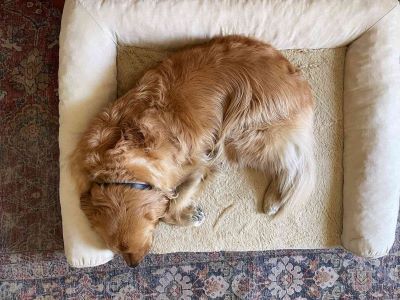
Here are some Dos and Don’ts of Washing Your Dog’s Bed with Hands:
| Dos | Don’ts |
|---|---|
| Use a gentle, pet-safe cleanser | Avoid harsh detergents or bleach |
| Gently agitate the bedding | Don’t scrub aggressively |
| Rinse thoroughly with clean water | Don’t use excessive force |
| – | Don’t wring or twist the bedding |
4. Challenging Stains and Odors
Stains and odours can be a real challenge when cleaning your dog’s bed. Here are some tips to remove them:
- Vinegar and Baking Soda: Apply the paste to the stained area, let it sit for 15-30 minutes, and then blot it up with a clean cloth. Follow this with a mixture of equal parts water and white vinegar, gently dabbing the stain.
- Hydrogen Peroxide: Hydrogen peroxide can be effective against bloodstains. Apply a small amount directly to the stain, let it bubble and fizz, and then blot it up with a clean cloth. Rinse the area with cold water and pat dry.
- Lemon Juice and Salt: Combine lemon🍋 juice and salt to create a paste for tackling food or grease stains. Apply the paste, let it sit for 15-30 minutes, then gently scrub the stained area. Rinse thoroughly and dry.
- Enzymatic Cleaners: Enzymatic cleaners are designed specifically to break down organic stains and odours, making them effective for pet messes. Follow the manufacturer’s instructions carefully when using these products.
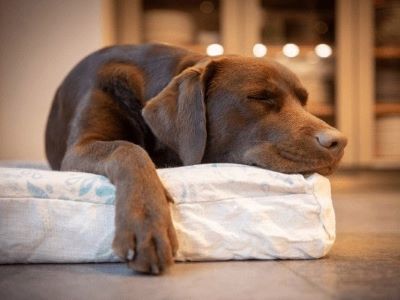
Before applying any commercial stain and odour remover to your dog’s bed, perform a patch test on a small, inconspicuous area to check for any adverse reactions.
5. Drying Your Dog’s Bed
After cleaning your dog’s bed, the drying process is a crucial step in ensuring it’s ready for your furry friend:
Air Drying
It’s a gentle method that helps maintain the bed’s shape and integrity. Try to place the bed outdoors in direct sunlight. This not only dries the bed but also helps kill bacteria🦠 and eliminate odours naturally.
Ensure the bed is well-supported during air drying to prevent sagging. Periodically flip the bed to allow both sides to dry evenly.
Air drying may take a bit longer, but it’s worth the wait to preserve the bed’s quality.
Machine Drying
If the care label suggests machine drying, follow those instructions closely. Always use a low heat or gentle cycle to prevent damage. Adding dryer balls or clean tennis balls to the dryer can help fluff the bed and distribute heat more evenly.
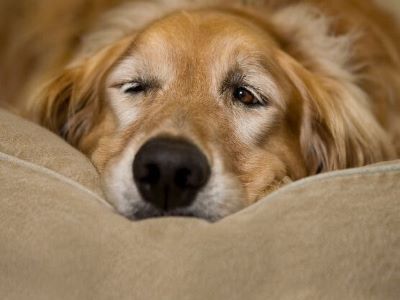
Periodically check the bed during the drying cycle. Remove it once it’s fully dry to avoid any potential damage from excessive heat.
Speeding Up the Drying Process
After squeezing out excess water, place clean, absorbent towels in between the layers of the bed. This can help speed up the drying process by wicking away moisture. If you are air drying indoors, position fans or dehumidifiers nearby to improve air circulation and reduce humidity. This can expedite drying.
Once your dog’s bed is clean and dry, it’s time to reassemble it and make it inviting again:
Fluffing Up the Bed
Give the bed a good shake to distribute the filling evenly. Fluff the bed by manually adjusting the stuffing or padding to restore its original shape and comfort. If the bed has pillows or cushions, plump them up to ensure they’re fluffy and supportive.
During the fluffing process, inspect the bed for any damage or loose stitching. Repair any issues promptly to extend the bed’s lifespan.
Making It Inviting Again
If your dog’s bed has removable covers or linens, consider using clean, fresh ones. This adds an extra layer of cleanliness and comfort for your pet.
To make the bed even more inviting, place your dog’s favourite toys or blankets on it. Familiar scents can be comforting and inviting.
Gently encourage your dog to use the newly cleaned and fluffed bed. Offering treats or praise can help them associate the refreshed bed with a positive experience.
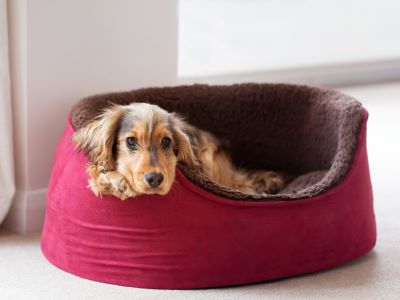
Dogs may dig in their beds out of instinct or to fluff up the bedding. Understanding why do dogs dig in bed can help you address the behavior.
Tips for Maintaining a Clean Bed Routine
Maintaining a clean dog bed is essential for your pet’s health and comfort. Here are some tips:
- Consider more frequent washing if your dog is prone to shedding has allergies or is accident-prone. If the bed retains a noticeable smell even after regular cleaning, it’s time for a deep clean.
- Stains that don’t come out with routine washing indicate the need for a more thorough cleaning. Examine the bed’s creases and seams; if they’re filled with dirt or debris, a deep clean is warranted.
- If your dog shows signs of allergies, like excessive scratching or sneezing, a cleaner bed may help alleviate symptoms.
When the bed’s padding becomes compressed or matted, it no longer provides adequate support🤝, and it’s time to fluff it up or replace it.
For older dogs or pets with joint pain or arthritis, the best orthopedic dog bed uk provides essential comfort and support. Be sure to check the washing instructions before cleaning orthopedic beds, as some materials require special care.
FAQs
❓How Do You Clean and Sanitize a Dog Bed?
Always check the bed’s washing instructions. Wash the bed and removable cover in separate loads on the hottest water setting to kill germs. Add laundry detergent and ½-cup of vinegar to each load and run a rinse cycle after.
❓How to Wash a Dog Bed?
Many dog beds can be machine-washed with detergent and warm or hot water, but you can also add baking soda and white vinegar to the wash cycle to prevent fabric-destroying pet odours. If you don’t have time, spot cleaning using soap and water will do just fine.
❓How Do You Wash a Dog Bed by Hand?
Fill up a large basin or bath with enough water to completely submerge your dog’s bed. Soak the bed in warm water with a non-toxic detergent for 10-15 minutes. Scrub with baking soda to remove any lingering odours, using a toothbrush to get into the corners. Rinse thoroughly.
Summary
Ah, the joy of a clean and fresh dog bed! We’ve unveiled the secrets to maintaining your furry friend’s bed as a cosy and pristine retreat. But how to wash a dog’s bed?🛏️
It may seem like just another chore, but it’s a vital act of love for your canine companion, regularly washing your dog’s bed comes with benefits for their health and happiness. It’s more than just cleaning; it’s a gesture of care and affection.❤️🩹
So, embrace this chore with a smile, knowing that it’s another way to keep your beloved pet healthy and happy!
Reference:
- Staff, A. (2022a). How to clean a dog bed. American Kennel Club.



